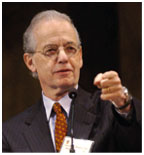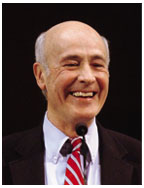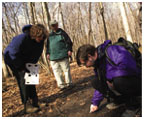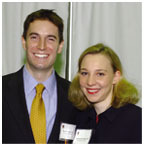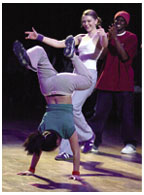March 24, 2004: Notebook
College admission dos and don’ts

This year’s Madison Medal went to Harold Shapiro *64, top; Joseph Nye ’58 received the Wilson Award. (Denise Applewhite)
Taking part in a campus nature walk on Alumni Day, from left, Sara Roberts s’75, Richard Reilly, Rick Curtis ’79, and Bill Sachs ’66 examine animal tracks. (Ricardo Barros) The Moses Taylor Pyne Prize, Princeton’s highest academic award for undergraduates, went to Steven Porter ’04 and Katherine Linder ’04. (Denise Applewhite) |
Winners of the Porter Ogden Jacobus Fellowships, Princeton’s top award for graduate students, were, from left, William Ristenpart, Jennifer Waldron, Eric Brown, and Min Hu. (denise applewhite)hen Harold Shapiro *64 came to Princeton to attend graduate school, he was anxious to study under Jacob Viner, the renowned international economist. But when Shapiro went to Viner’s office, only Viner’s books remained, stacked unceremo-niously outside the door as a junior faculty member carted in his own belongings. Viner had retired.
Shapiro overcame his initial disappointment and embarked on an educational journey that he says “transformed” his life. At Alumni Day, February 21, the former University president was presented with the James Madison Medal, the University’s highest award for a graduate alumnus, as he joined 1,450 other alumni to celebrate and reminisce about their time at Princeton.
Shapiro and Joseph Nye ’58, the Woodrow Wilson Award honoree, kicked off the day with lectures at Richardson Auditorium. Shapiro spoke about ethics and change in universities in the context of science and globalization, advocating individual ethical responsibility as professors and researchers. “It would be helpful if [universities] did more to help young people understand that their contributions to society need to reflect both skill and moral accountability,” he said.
Nye, the dean of Harvard’s John F. Kennedy School of Government and an assistant secretary of defense in the Clinton administration, returned to the Richardson stage for the first time since Class Day in 1958. He addressed diplomatic strategies for improving the United States’s relationships with other nations. While the U.S. is likely to be the world’s only superpower for decades to come, Nye said, cooperation with the rest of the world will be needed, diplomatically and economically. “When we discount the importance of our attractiveness to others,” he said, “we pay a price.”
Rounding out the day’s events, Dean of Admission Janet Rapelye spoke to a crowd of 300 about the realities of college admissions in today’s hyper-competitive world, and members of the chemistry department demonstrated chemical reactions involving energy and change. Some in the audience were under 10 years old, while others were old enough to remember Professor Hubert Alyea ’24 doing the same demonstrations.
Outdoor Action hosted a nature walk and indoor rock-climbing. Engineering undergraduates built Lego bridges with children. Professor Toni Morrison read from her latest novel, Love, and Nancy Weiss Malkiel, dean of the college, and Janet Smith Dickerson, vice president for campus life, answered questions about undergraduate life.
In the Service of Remembrance, representatives of the Classes of 1929 through 2007, the Graduate School, and University staff, participated in a memorial procession at the Chapel, placing white carnations in a wreath to honor Princetonians who died in the last year.
Earlier, at an awards luncheon in Jadwin Gym, Nye and Shapiro spoke about their student experiences at Princeton, with Nye recalling one ill-fated, nighttime mission to snatch the bell clapper from the tower atop Nassau Hall. Nye fell halfway through the ceiling, though he escaped with life and limb — and Princeton enrollment — intact.
By B.T.
Alumni Awards
Alumni Council Award for Community Service
The Class of 1956’s ReachOut ’56
S. Barksdale Penick, Jr. ’25 Award (for local Schools Committee
work)
The New Zealand Alumni Schools Committee, the Princeton Club of San Diego,
and the Princeton Alumni Association of Central New York
Class of 1926 Trophy (for raising the largest amount for Annual
Giving in a given year)
The Class of 1963
Jerry Horton Award (for efforts to increase Annual Giving amounts
and participation)
The Annual Giving Committee of Vero Beach, Florida
Harold H. Helm Award (for exemplary and sustained service to
Annual Giving)
Joseph Bolster ’52
![]()

(Photo: Frank Wojciechowski) |
During “This is Princeton,” a showcase of University talent
held February 26 at Richardson Auditorium, members of Sympoh Urban Arts
Crew show off their break-dancing. Here, Beverly Lien ’06 struts
her upside-down stuff, while Antonina Savostyanova ’06 and Adler
Perotte ’06 look on. Other students, staff, and faculty members
played instruments, sang, and read from their work.
![]()

Early on Alumni Day, parents and sleepy-eyed teenagers filled a 300-seat auditorium in McDonnell Hall to solve the riddles of college admission. Dean of Admission Janet Rapelye and Nick Allard ’74, chairman of the National Schools Committee, had promised to speak on “everything you wanted to know about preparing to apply to college but were afraid to ask”; while they revealed few trade secrets, they did offer plenty of tips:
Reality check: There are more than 3,000 colleges and universities in the U.S., all with different personalities, strengths, and weaknesses. Stow your Princeton sweatshirt in the closet, Rapelye advised; while it suits you perfectly, it may not fit your child. Instead, help your child explore the options and keep the search focused on the child’s interests. And when you visit a campus, never say, “We’re here for our interview.”
Recommendations: Though the most important thing in an applicant folder’s is a transcript showing a record of curiosity and academic excellence, recommendations also count – a lot. Students should seek recommendations from teachers who truly know them, and can speak to their engagement in class. Choose the writers carefully, or the results may be similar to this actual, one-line reference: “Roger appears to be personable and alert, but he isn’t.”
Extracurriculars: Colleges seek commitment and consistency, not a long list of activities. “It’s not looked upon well if you take and drop new activities each year,” Rapelye said.
The essay: “How well you write is a reflection of how well you think,” Rapelye said. A good essay uses simple, compelling language that brings out the student’s voice. A bad essay may read as though it came straight from the thesaurus. Don’t do it.
Offering help: How much help is too much? Rapelye said it’s fine to read your child’s essay, and appropriate to give the sort of feedback that an English teacher might offer on a paper. More than that is too much. If you feel the urge to rewrite your child’s essay, don’t. Admission officers can tell.
Early birds: Don’t try to “game” the system by applying through the early decision process, Rapelye said. Though early-decision applicants historically have been admitted at a higher rate than other applicants, the process is only for students who really know where they want to go, she said.
Testing, testing: Princeton students have average S.A.T.
scores in the low 700s, so be realistic about how your child compares.
How much do scores matter? Said Rapelye: “They mean less than you
think they do — but probably more than we say.”![]()

Photo by Bill Hayward
|
In the Middle East, President Bush has initiated “a war that will never end,” says Al Franken, political satirist and author of Lies and the Lying Liars Who Tell Them (Dutton). In a February 26 appearance at the Woodrow Wilson School that was part comedy and part deadly serious, Franken lampooned Republican policy and criticized the administration for its claims on job creation and its stand on gay marriage and the Iraq war.
While the 9/11 tragedy produced an American nation that had never been more united, said Franken, President Bush’s political and military reaction to the terrorist attacks was inappropriate.
“This President had an opportunity to lead this country and the world into a new democratic century, and he blew it,” Franken said. “He hijacked 9/11 for political purposes, and he knows that.”
— Jordan Paul Amadio ’05
Self-censorship is the “biggest burden” in journalism, said Seymour Hersh, investigative reporter for the New Yorker, in a February 25 talk at the Woodrow Wilson School. Hersh held little back in his comments, making verbal jabs at Henry Kissinger, television news networks, and Bill Clinton.
Hersh’s favorite target was the Bush administration, which he criticized for its capriciousness with reporters. “All White Houses get mad,” Hersh said, “but these guys really hold a grudge.” The environment has not made reporting in Washington entirely hopeless, though. The Pulitzer Prize winner said there are still people in the military, intelligence, and bureaucratic communities who are willing to provide the inside scoop on policy and practice.
— B.T.
Photo by Studio Daniel Libeskind |
The 1,776-foot Freedom Tower, to be built where the Twin Towers once stood, will represent “a resilent, open future,” said Berlin-based architect Daniel Libeskind, who last year won the international competition to rebuild New York City’s Ground Zero. Speaking February 24, Libeskind shared his thoughts about architecture’s role as a force of remembrance to “evolve an emblematic and visceral feeling about something that is positive, something about life.”
Discussing his design for the Jewish Museum in Berlin, which opened in September 2001, after a decade of development, Libeskind noted that buildings can both shape and reflect cultural memory. A building, he said, should be “not just a container,” but should capture the “invisible dimension” of experience.
“The plan for the Ground Zero site will be based around a memorial, but it will be more — a living memory, that is alive in every sense,” said Libeskind. “We will build not just with materials, but with hope.”
– Jordan Paul Amadio ’05
To hear Libeskind’s talk, go to www.princeton.edu/WebMedia/lectures/.
![]()

